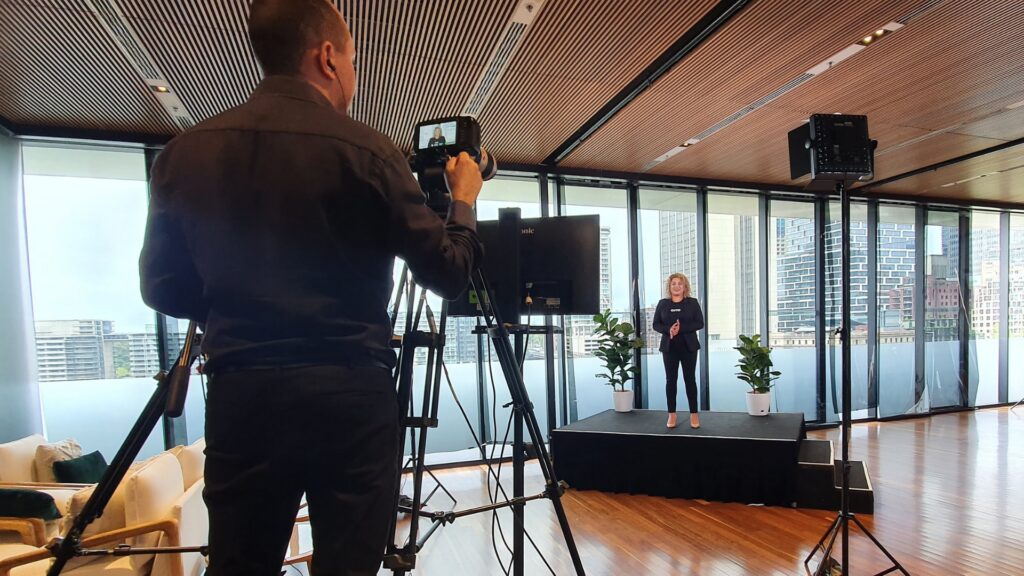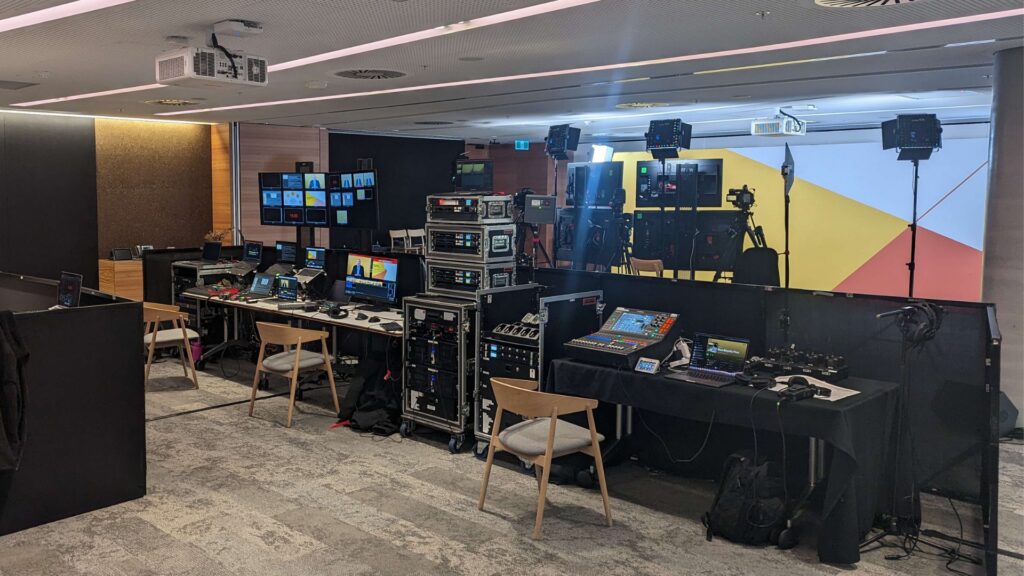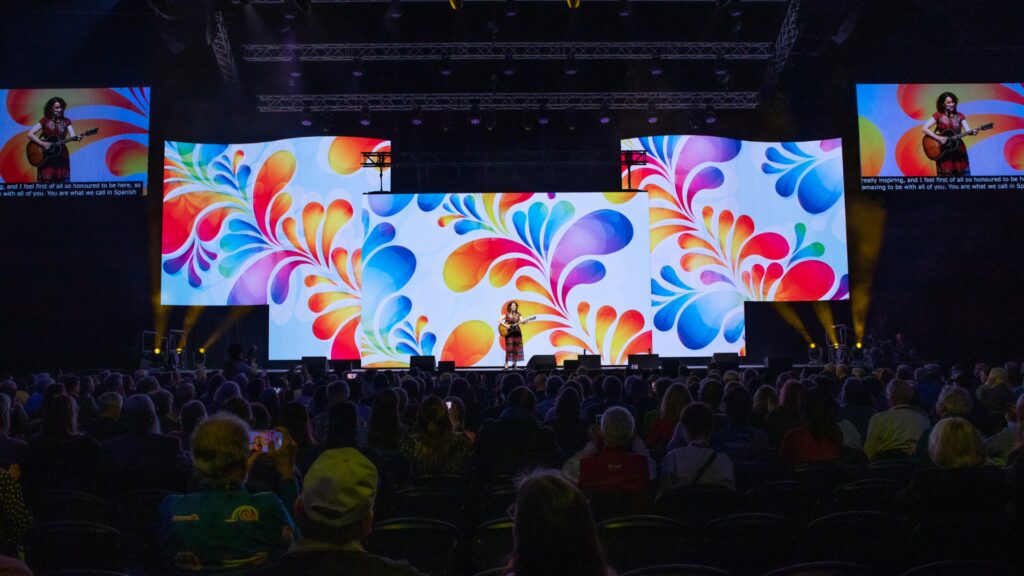
Customer Spotlight: AV1 – a Virtual, Hybrid and Live Events Company
Just shy of the holiday period last December, our CEO James Broberg had the pleasure of (virtually) sitting down with long-time customers, AV1, to discuss the challenges, trends and opportunities of the last 3 years producing virtual, hybrid and in-person events.
AV1 has a long and storied history designing and producing events, offering services across audio visual production, content creation and event technology across Australia. They are curators of premium event experiences, helping clients leave a lasting impression on their attendees, audience and stakeholders – whether that’s in a live, hybrid or virtual environment.
Like StreamShark, they are customer obsessed, and since they approached us in March 2020 just as Australia and the world was shutting down, we have worked together to ensure engaging and interactive events could be run virtually, and as restrictions eased, transitioned to hybrid and in person focused productions.
AV1’s Nigel Mintern and Tom Durand were kind enough to chat with James on their last working day of the year, as they collectively reflected on a busy and rewarding time, and considered what the future of digital events looks like in 2024 and beyond.
James Broberg: Today I’m sitting down with some of the folks at AV1 to chat about how they utilise StreamShark in their workflow and to learn more about their company as a whole.
To get things started why don’t you introduce yourselves, your role, and where your journey at AV1 started.
Tom Durand: Hi, my name is Tom Durand, I work with AV1 as a Technical Director. Day to day, I work with a production manager. We work as a duo producing events.
Once the event has been confirmed, I then own the technical production. I make sure the equipment is spec’d correctly for the job, then dot the i’s and cross the t’s to ensure everything runs smoothly on the day.
Nigel Mintern: I’m Nigel Mintern, a Producer here at AV1. I started with the company almost 14 years ago now as a technical operator and worked my way up the ranks to Technical Director, and now Producer.
I work with the clients first to bring new ideas, help them define their creative vision and turn that into a production. Then working with our Technical Directors and production team, we deliver the event, encompassing countless hours of pre-production to make sure nothing is missed.
James Broberg: How long has AV1 been operating for? Were you part of the foundation team?
Nigel Mintern: AV1 will celebrate 20 years in business next year. I think I was employee number 12, back in 2010. So not quite the foundation, but not far off.
James Broberg: Yeah, wonderful. Can you talk at a high level in terms of the AV1 offering? Can you talk it through, what would be your dominant engagements with your clients?
Nigel Mintern: We produce business events of all kinds, ranging from intimate boardroom meetings all the way to 5,000-person conferences, providing production services and equipment. Our typical type of work is in the corporate sector, you know, law, financial, medical those kinds of industries.
We really only got into live streaming when the pandemic started. Before COVID we ran maybe a handful of events each year, which we would actually live stream, and we onboarded an external provider to run those. That external provider used StreamShark, which we had great success with and that was how we learnt about the service.

James Broberg: Great to hear! Do you have your own studio spaces as well, doing events on-prem?
Nigel Mintern: We don’t have our own studio space anymore. During COVID, we had two dedicated studios. One was a converted warehouse which we cleared out and turned into a black box studio. And then we had a second one at the Museum of Contemporary Art Australia set up in what’s known as the Harborside Room with the Sydney Opera House in the background.
James Broberg: So it wasn’t all virtual? You could bring in the talent there as well?
Nigel Mintern: Yes, we of course respected and adhered to the restrictions in place at any given time. So you could bring people in, at times, it may have been a single person, depending on restrictions. It was a combination of virtual and in person.
James Broberg: So we did touch on it briefly before, but what brought you to us? And perhaps you could give us an idea of the problems you were trying to solve?
Nigel Mintern: Yeah we worked with our production partner, Dennis Fernandez, for our first live streams, but obviously it wasn’t the most cost-effective way for us to do it. Ultimately we looked at how to do it ourselves, and whether we go down a hardware or software encoder route, and the different components that come with that.
Having worked effectively with the back end of StreamShark and having it do everything that we needed, we decided to jump in and go on the StreamShark journey.
James Broberg: Did clients know what to ask for at the time? Did they just want their in-person events replicated? Or were they just looking for you to think about how you would creatively solve the problem we were all facing?
Nigel Mintern: Definitely, you know, I reckon the phone rang, multiple times from people just asking, OK, we want to hold a virtual event. What do we do? What’s needed? Nobody had an idea of what was required for a virtual event or what was needed.
Nigel Mintern: And so they were calling on us as their technology production company for our advice on how best to deliver events. Nobody really knew what to spin up at that point in time. We were quite lucky, we’d built our first studio, in its first format pretty quickly. I think we did our first event there at the end of March 2020. We were ahead of the curve in that sense, and we executed the events from there.
James Broberg: And what was your memory of the time, Tom, any curly technical challenges that you had to solve or you’re comfortable with the tools you had at hand and to bend them to your will?
Tom Durand: A lot of the time, we’re just building from the ground up. So trying to get all the networking together, the latency, the sync. It was all pretty similar, but different at the same time. So I just feel, since we had only a couple of spaces, the amount of events going through it, you are always kind of fixing a problem and trying to do something else in time. So it’s pretty fast and furious. But yeah, in the end, I think we got there and everything is much easier now.
James Broberg: Yeah, it was a chaotic, but a busy and rewarding time. A lot of challenges to be solved and a lot of fires to be put out concurrently is my memory of the time.
Nigel Mintern: A lot of learnings from our crew in terms of new skills as well. We hadn’t previously used things like vMix or other software, but then we had to learn how to use them.
And that side of it is very different to an in-person event. With the in-person events we ran, as the show finishes you play the music nice and loud and there’s usually a buzz in the room. But for virtual events, it kind of just finished and they went ‘thanks’ and off they went. It can really miss the hype at the end of an event.
James Broberg: Yeah, yeah.

Nigel Mintern: Let’s just turn the power switch off and walk out ourselves.
James Broberg: Haha, yeah, job done. It was a bit like that, wasn’t it?
That leads me into my next question, what sort of insights and reporting were clients asking for you at the time. In terms of moving from that physical space to virtual, whether they wanted immediate feedback to know how it’s gone.
Nigel Mintern: I think the biggest thing that people wanted was just the analytics of who dialled in and how long they watched for. I think that was one of the most important data points that people were just trying to understand.
In the early days, you’d have 100 people registered to watch something, and then you’d probably end up with 95 to 100 actually attending. Whereas now you put on an event with 600 people registered and you might only get 200 people watching. So the data on who watched the streams is crucial.

James Broberg: Yeah, absolutely. I guess stepping back a little bit, obviously things have changed a bit in the last three years in terms of the tools we have available now versus early 2020 and we all overcame a lot of challenges and did things on hard mode. I think the experience has driven a lot of innovation, certainly in the virtual production space and industry wide.
So what for you has been the most material change or improvement in terms of running these events?
Nigel Mintern: I think it’s just the ease of it now. It’s very easy to add a virtual component now in some shape or form to any event as an add on.
On the flip side of that, we see a lot of virtual presenters dialling into events. That’s probably more common now than the hybrid version. Whether it’s Reese Witherspoon dialling in from Paris for an event on the Gold Coast, to a GM who’s sick at home, but still wants to present. Obviously, it’s generally cost-saving, because you don’t have to pay for travel and things like that. I’d say that’s probably the main thing.
James Broberg: And Tom, anything on the tool side? Has there been one thing in particular that you’ve been impressed by in the last sort of 12 to 18 months with the rapid improvement of the tooling that we’re all using?
Tom Durand: I guess just the use of computers that are powerful enough to throw in application edits. Now it’s no longer one dedicated machine that does a dedicated task. Most computers are powerful enough to jump between a few different programs. You can have all virtual lines that tie it all together. So if you’ve got enough screens or are good at alt-tabbing, there you go, it’s all in one station.
James Broberg: Yeah, I definitely agree with that one. I think pre-COVID, our most risk-averse corporate clients would always want to use hardware encoders. And that at the time was using very expensive Elemental boxes, or Epiphan Pearls, which could be setting you back five to tens of thousands of dollars.
There just wasn’t the comfort level to use a consumer PC and a software encoder like Wirecast or whatever was current at the time. So I’d agree with that, Tom, it’s definitely evolved. The comfort level is much higher now to run a high-end production with vMix or even OBS. If you’ve got a good enough PC and you’re comfortable with the stability of it. And as you say, you can bring in virtual presenters. You can stream it out from the same box and be pretty comfortable that it’s mostly going to work. And if you’ve got a backup, you’re feeling pretty good about it.
We’ve seen a maturation of tools and gone are the days of pinning machines for each virtual presenter on a Zoom or a Meet, like a literal $3,000 PC just to capture some terrible quality video conference.
If the talent is remote, whether it’s a CEO that’s sick or Reese Witherspoon in another country, as long as she’s got a good mic and camera and knows how to use Teams or Zoom, you can get something pretty good out of it too. That used to be a challenge, not impossible, but challenging and inefficient. Now it’s a very integrated part of most of the virtual production tools we see out there.
That’s all super positive in our books in terms of a good trend that lowered the bar, but uplifted the quality as well.
Looking beyond that, is there anything that is the missing piece? A lot of the hard problems have been solved, but is there something out there that you still think, I wish worked better or I wish this was more compatible or coherent, or is there something out there that can save you guys time?
Obviously, AI is a very buzzy thing right now, but is there anything in your mind in the AV space where that could enhance anything in terms of extracting metadata or summarising or shot selection or anything like that?

Tom Durand: I think the biggest problem we often run into is just internet bandwidth. So, if you want to do something a bit ritzy, high resolution, high bit rate, you can run into problems pretty fast. Because live streaming still definitely seems to run by the rule of test when you start and test often, and if you don’t, it’s going to get stung pretty hard.
James Broberg: And test where you’re running the event from.
Tom Durand: Which I always thought was a nice feature of StreamShark when you can test before you go live for an unlimited amount of time. It does make everyone pretty sure of how everything’s going to work. Because a few of the other providers just cut you off 10 minutes after you start.
But yeah, I think the internet is always the biggest crutch. Everything else you can kind of spec out because you have some form of ultimate control over it. But sometimes you go to someone’s building, and you just can’t connect to their network. So you’ve got to bring in all these wireless temporary solutions and they’re just not as robust.
James Broberg: Yeah, absolutely. I’m out at the coast at the moment and 4G’s worked quite well down here until recently. It’s starting to really get over subscribed. So, I’ve been hooking up a Starlink today. It can provide some interesting possibilities for a remote event where you could literally be anywhere with a view of the sky and be able to get an uplink at least within reason. So, I guess there’s options on that front. There’s bonding and other enhancements that haven’t solved all the problems, but have made things a little bit better.
We are also seeing more efficient codecs coming into play, like HEVC 265, AV1 (the codec) and SRT. HEVC 265 is not exactly new, but there’s in the order of 30% savings there if you’re using that as a contribution mechanism.
AV1 (the codec) is becoming mature and the hope is you could, in a constrained environment, push out a high quality signal with less bandwidth.
We’ve recently supported SRT as well, which is secure, reliable transport, and that gives you a little bit more rope, to try and get a reliable signal out of a challenging environment. It doesn’t solve all your problems, like if your internet goes down for two minutes, it’s not going to help you. But it can at least remove some of those hiccups and gives you a bit of buffer so your event is not impacted.
Tom Durand: It would be much easier with SRT than RTMP.
James Broberg: Yes, especially with the rise of 2K and 4K content, 50 to 80 megabit streams. We’ve seen great success with SRT and adjusting the buffer depending on how far from the ingest you are.
The other thing we’ve seen is the rise in the importance of accessibility. Depending on the country there’s all sorts of obligations coming down the pipe from a regulatory perspective. Is that something you’re being asked for in terms of, closed captioning, supporting multiple languages, ASL, that sort of stuff?
Tom Durand: I think close captions come around frequently. Sometimes it can be kind of hard to do roundabout. Do you send your signal to someone that gets a human to do it so you can make sure that it’s going to be good, it’s going to be pretty latency heavy there, or do you trust the computer AI system that quite possibly, on a key line, will display a typo and it’ll just look a little bit rough?
James Broberg: Yeah, we’ve had streams that make the papers because of the quality or lack thereof of the captioner for high profile streams. It can happen. I think people are pretty forgiving, but it can definitely happen.

Tom Durand: I remember the first time I ever used close captions inside an encoder, I think it was Wirecast, it would literally spit back garbled nonsense, like they weren’t words.
Obviously, it’s easier to close captions on an uploaded video, but doing so on a live stream would be a great asset.
Also having multiple channels of audio in different languages. Not that we do that very often, but if someone ever has the question, it always does seem a little bit tough.
James Broberg: Yeah, I think that’s definitely meeting the Holy Grail in the corporate space. I’d have to check how far progressed it is, but I know we have a POC for the multi language option, because I think that’s kind of the dream for a lot of corporate events. Having a single player with switchable text captions, and audio languages.
We certainly support multiple captions for text-based captions for 608/708 within the same player. Yeah, it is, as you say, quite hard to do live. In particular with human captioners or depending on the accuracy of AI or ML based ones, which to be fair has gotten a lot better in the last three or four years we’ve noticed, but still quite hard to do live.
All right, I’ll start wrapping up this conversation. Are there any final thoughts you want to share?
Nigel Mintern: One thing I will say, James, is that we really appreciated how early on in the piece was StreamShark’s willingness to put into place new features and changes to our benefit. Your team very quickly developed elements to help us service our clients. We very much appreciate that responsiveness and how open to new ideas your team is.
James Broberg: I’ll say, I appreciate that positive feedback. They were all good suggestions that we could see value in. Our mindset’s always been to build things for the operators and make workflows that save you time and give you insights to help measure your ROI.
Nigel Mintern: Yes, your adaptiveness has been great!
James Broberg: Well I’ll wrap up the interview now, it was great having a chat and learning more about yourselves and AV1.
Tom Durand: Thanks James.
Nigel Mintern: Great to chat James.
